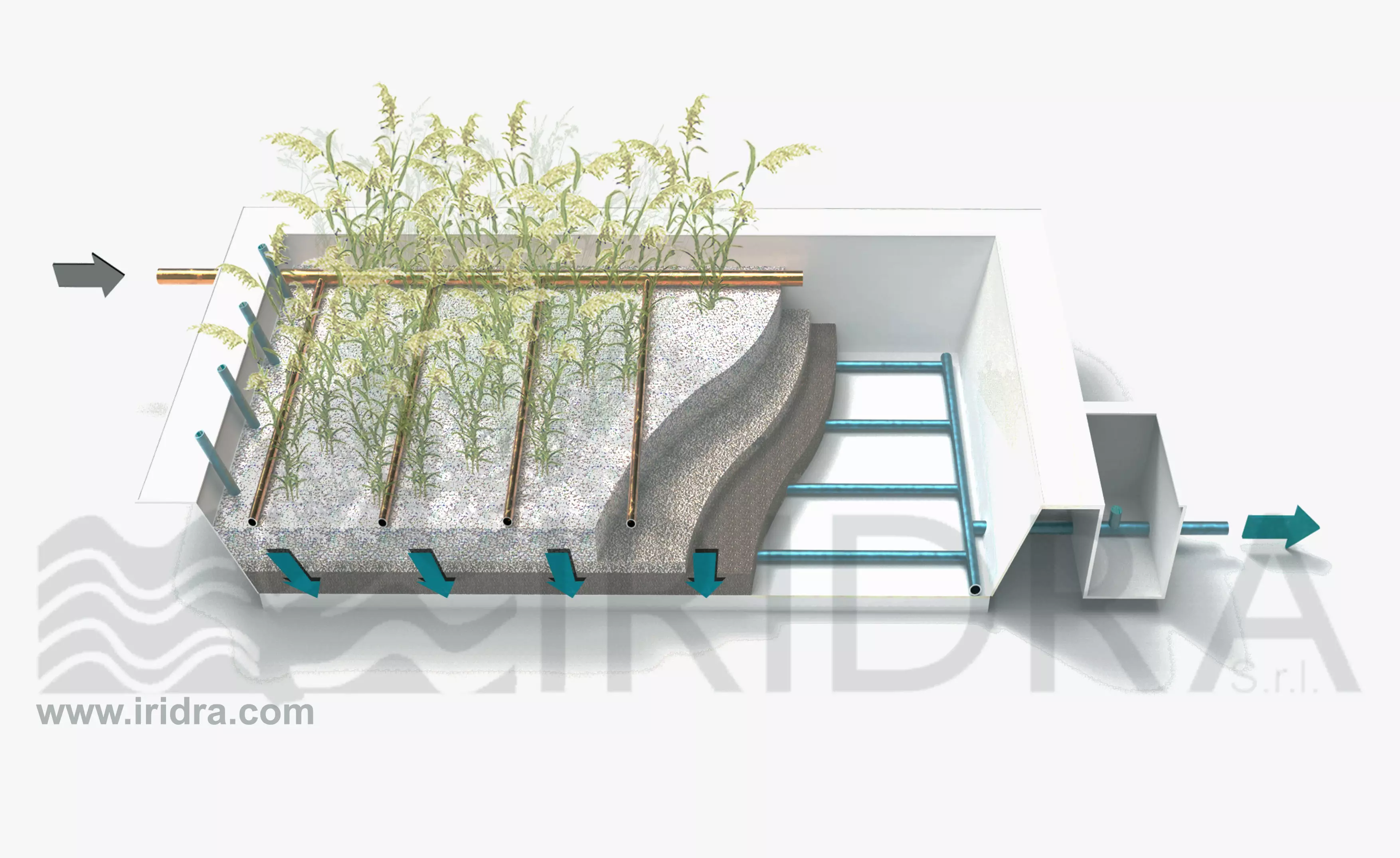Vertical subsurface flow systems (VF)
Vertical subsurface flow constructed wetlands (VF) is composed by one or more parallel beds filled with gravel and sand of different sizes. Wastewater is distributed on the top of a VF (with pump or syphons) and vertically percolates through the bed, finding aerobic conditions. The feeding is in batch and the bed are planted with macrophytes.
VF technology is one of the most applied nature-based solution for wastewater treatment in North-Europe, also due to a functioning that does not depent on temperature for the removal of organic pollutants. VF is also widely used in Italy, thanks to the high removal efficiencies and a relatively low areal footprint.

The configuration of these systems is similar to the horizontal subsurface flow system. The difference is that the wastewater flows vertically through the filling media (percolation) and that a load of wastewater into the basins is intermittent and discontinuous, rather than continuous with plug flow as in horizontal systems.
This typology of the system with an intermittent flow (batch reactors) normally implies that at least two basins in parallel for each line are utilized. These basins in parallel work with alternate flow, so that is possible to regulate re-oxygenation times of the beds by varying frequency and quantity of in hydraulic load. These variations are made utilizing syphon devices or electric pumps correctly dimensioned.
Peculiarity and differences from HF systems
The vegetal species utilized are the same used in horizontal flow systems.
The filling media used in vertical flow beds, on the opposite, is different from the one used for horizontal flow bed: the granulometry is not constant inside the bed. Layers of gravels of different dimensions are disposed into the basin, starting with a layer of sand at the top and arriving at a layer of stones above the drainage system at the bottom. Vertical flow systems, still relatively new in constructed wetland world but already sufficiently validated, present the characteristics to permit a remarkable diffusion of the oxygen also in the deeper layers of the basins, due to the fact that the diffusion of oxygen is about 10.000 times greater in air than in water, and to alternate periods with oxidant conditions to periods with reducing conditions.
Hydraulic retention times in vertical flow systems are quite short; the superficial layer of sand lessens the velocity of the flow, and this favours both denitrification and Phosphorus adsorbing by filtering media.
Phenomena of superficial clogging, due to the input of suspended solids, are desired in a first period, because solids favour homogeneous diffusion of wastewater on all the surface of the bed, but have to be taken under control in the long term, in order to avoid the formation of stand water. Foreign experiences (Maeseneer, 1997) on these systems show that clogging does not take place when the discontinuous alimentation is lower than the maximum hydraulic load in case of continuous alimentation and when the vegetation has an adequate development (the action of wind, in fact, gives place to movements of the sand in the root zone and around the stalk that contrast clogging).

Example of a feeding system of VF CW
Removal efficiencies
High removal efficiencies are obtained in terms of organic, suspended solids, and pathogen contaminants. Almost complete nitrification is possible, due to the aerobic environment developed into VF beds.
| Pollutant | Concentration IN (mg/l) | Concentration OUT (mg/l) | n° VF WWTP | Removal efficiencies (%) |
| BOD5 | 309 | 21 | 97 | 87.9 |
| COD | 547 | 70 | 115 | 78.6 |
TSS | 188 | 18 | 74 | 77.1 |
| NH4-N+ | 56.4 | 10.6 | 79 | 94.0 |
| TN | 70 | 37.6 | 64 | 44.0 |
| TP | 10.6 | 4.6 | 94 | 48.3 |
Removal efficiencies of VF systems for urban wastewater in Europe (Vymazal et al., 2008)

